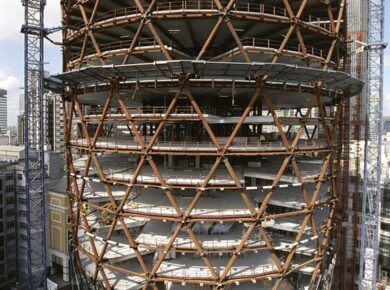Opening of The Newport Transporter Bridge (12 September 1906).
The remarkable Newport Transporter Bridge is the largest and one of only eight surviving transporter bridges left worldwide from a total of twenty constructed. The bridge opened in 1906 and has dominated the Newport skyline since.

Photo: WelshDave
A transporter bridge is basically a suspended ferry that can operate more efficiently than a conventional ferry. A high level boom that allows ships to pass underneath is suspended from towers at each end. The boom carries a rail track on which a moving carriage or ‘traveller’ runs. A gondola or platform is suspended from the carriage and can be pulled from one side of the river to the other by means of a hauling cable. The Transporter Bridge is powered by twin 35 horse power electric motors.

Photo courtesy Newport Museum and Art Gallery
Although an ‘aerial ferry’ was the idea of English engineer Charles Smith, the first working example was built by Spaniard Alberto Palacio and Frenchman Ferdinand Arnodin in 1893 at Portugalete near Bilbao in Spain.

Photo courtesy Newport Museum and Art Gallery
A transporter bridge offered an economical solution as tunnelling was technically difficult and expensive and a conventional bridge required a very long approach ramp to gain enough height to maintain a waterway for the tall ships of the day. Haynes and Arnodin were appointed joint engineers and the contract to build the bridge was given to Alfred Thorne. The bridge costed £98,000 to complete and was opened on September 12, 1906. The bridge is currently closed for restoration works and will be reopened in the summer of 2023.
About the Author:

Bruno Dursin – Managing Director at Believe in Steel. Bruno has more than 30 years of experience in promoting steel & steel solutions. His clients benefit from his extensive network within the building industry.



